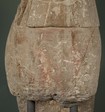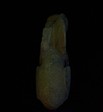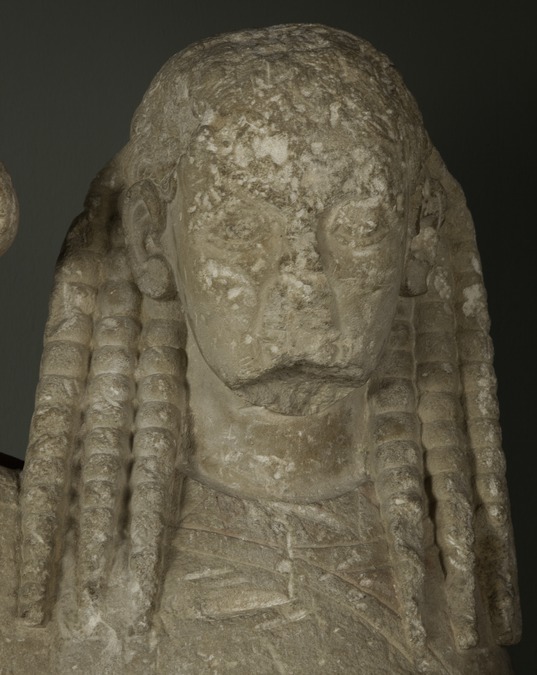Sphinx
Summary
On this archaic, limstone sphinx, well-preserved paint adds to the striking appearance. Clear traces of red ochre are visible to the naked eye on large areas of the sphinx and a few traces of yellow and blue are also found. A small sample was taken for binding media analysis. On the basis of the results of the analyses it is possible to state that the sample contains a saccharide material. It may be hypothesised that the paint binder was a polysaccharide material, such as a plant gum.
Description of object
The hair is held together by a flat frontlet while the hair above the band and the long mane hair have been rasped smooth, with the probable addition of colours.
Archaeological Commentary
Stone sphinxes were set up as votives in sanctuaries and as tombstones
Choice of methods
Visual examination
- Macroscopic
- Microscopic in situ
Technical imaging
- UV
- Raking light
Sampling
- Cross section
- Microscopy
- Microchemical spottest
- SEM/EDX
- XRF
- FT-IR
- GC-MS
Visual examination
Red is found on a large area of the chest, on the front edge of both wings, along the entire underside of both wings, in many areas along the edge between the flight feathers, on the band around the head, on the right side of the hair, between each of the locks of hair, on the right side, under the wing, on the rump, on the underside of the body between the forelegs, on four of the triangular ornaments on the neck, corresponding to every other one of these ornaments and along the bottom edge of the border which marks off the chest from the plumage. Yellow is found on the back of the hair, on one of the feathers on the back of the right wing, below the right eye, on the left shoulder and on the left side of the abdomen. Only a few traces of blue are found on the right shoulder
Technical imaging
UV-FL A bright orange is seen in an uneven layer over most of the sculpture, especially on the wing feathers and under the eyes. To what this fluorescence is due has yet to be determined.
VIL VIL- imaging was performed without any result
Other types of investigation
Samples: 1 Red from the chest 2 Red from the damaged patch on the chest 3 Red from the area between the feathers on the back of the left wing 4 Black (?) from the feathers on the back of the left wing 5 Light blue (probably modern) from the left shoulder 6 Blue from the right shoulder 7 Black dots from the right wing 8 Black from the left shoulder 9 Yellow from the feathers on the back of the right wing 10 Yellow from the left shoulder
SEM/EDX" Sample 1-2- 3 showed a content of iron-oxide suggesting the use of hematite or red ochre. Sample 4 from the black on the back of the left wing produced no clear result. On the other hand, a high content of titanium (Ti) indicates that the black might be pollution. Sample 5 The blue from the left shoulder was modern based on the high content of titanium (Ti) Sample 6 blue from the right shoulder showed a small content of copper (Cu), though this was not persuasive Sample 7 & 8 the uniform round, black balls from the right wing and left shoulder was probably a contamination from cinders Sample 9 yellow from one of the feathers showed a high content of iron indicating the use of yellow ochre. Sample 10 yellow from the left shoulder is still awaited.
XRF Several places on the sphinx were examined. All red areas showed a content of iron-oxide based on red ochre.
Micro-chemical analysis Micro-chemical analysis was carried out on samples from the red pigment found on the chest. The analysis of cinnabar (HgS) and red lead (Pb3O4) was negative, while the analysis of hematite was positive
Cross-section. Only one layer was detected. The pigment was fine-grained. The pigment grains are found located between white, semi-transparent grains from the stone.
FT-IR spectroscopy Sample 1 was examined to detect a possible binder. The result did not show any content of protein. However it did show a content of another organic substance which might be wax or oil, probably of recent character due to the tops around 2923 and 2854 Cm-1
GC-MS- binding medium analysis Sample 1 was subjected to an analytical procedure for the determination in the same sample of: proteinaceous materials (animal glue, milk or casein, egg, garlic), polysaccharide materials (starch, tragacanth gum,. Arabic gum, fruit tree gum, guar gum, karaya gum), glycerolipids (linseed oil, walnut oil, poppy seed oil, egg), natural waxes (beeswax, Carbauba wax), plant resins (Pinaceae resin, mastic, dammar, sandarac) and animal resins (shellac). The sample weighed less than 0.1mg. The results relative to the proteinaceous, lipid, resinous and saccharide fraction are as follows:
Proteinaceous The proteinaceous material content was below the detection limit level. This indicates that the sample does not contain proteins, or that the amount of proteins was below the detection limit of the procedure. A larger sample is needed to rule out the presence of a proteinaceous material.
Lipid The sample did not show significant occurrence of lipid resinous samples. This indicates that the sample does not contain lipids and resins, or that the amount of lipid and resinous materials was below the detection limit of the procedure. A larger sample is thus needed to rule out the presence of a lipid resinous material
Saccharide The sample showed the occurrence of saccharide material above the quantitation limt. This indicates that the sample contains saccharide materials. The sugar profile does not correspond to any saccharide binder, such as Arabic, tragancanth or fruit tree gum. Actually it is known that saccharide materials are subjected to degradation phenomena which are not understood at all. These degradation phenomena can induce modification of the sugar profile of a polysaccharide material so that its identification become questionable. Although the source of the saccharide material in the sample cannot be identified, it is possible to hypothesise that the sample contained a polysaccharide material, such as a plant gum.
Bibliography
F. Johansen (1994), Catalogue, Ny Carlsberg Glyptotek- Greece in the Archaic Period, Copenhagen.
M.L. Sargent, L.R. Spaabek, M. Scharff & J.S. Østergaard (2009), Documentation and investigation of traces of colour on the Archaic Sphinx NCG IN 120, in J.S. Østergaard (ed.), Tracking Colour. The Polychromy of Greek and Roman Sculpture in the Ny Carlsberg Glyptotek. Preliminary Report 1 (Copenhagen 2009) “Download”:
- IN 1203
- Statue
- 570 B.C.E.
- Archaic
- Porous Limestone
- Acquired in 1895.
- H. 84 cm.; W. 170 cm.



















